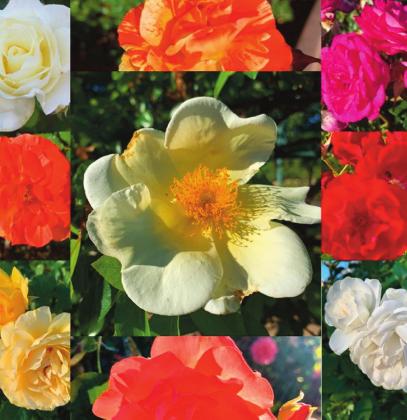Many roses grow well in New Mexico, even with minimal care and relatively low amounts of water. For more details from the following archived columns and answers to other common rose questions, visit the blog version of this column at https://nmsudesert-blooms.blogspot.com/.
Question: Is it too late to plant roses now?
Answer: In all of New Mexico, it is too late to plant bare-root roses (those that come in the pack with sawdust around the roots). However, containerized roses (those in pots in the nursery) can be planted. They may suffer some transplant shock, so be careful to keep them moist and protected from full sunlight and wind for a while after you plant them. You can do this by placing them inside a tomato cage wrapped with white floating row cover material or any porous white material that diffuses light and blocks the wind. As the plant establishes and grows too large for the tomato cage, you can re move the covering.
Question: Why are my rose blossoms ugly? The petals are brown and distorted.
Answer: There are several potential answers to your question. One is that the flowers are infested with thrips. Thrips are exceedingly small insects that are a problem with roses, especially in their first blooming of the year. If you carefully check inside the flower, pulling the petals open, you will often see a small speck scurrying away. This is the thrips insect. (Yes, there is an "s" on the end of its name even when we are speaking of a single thrips.) There are insecticides labeled for controlling thrips on roses. Call your local Cooperative Extension Service office for information or check at your local garden center for a product that will work for you. Be sure to read the label and follow the directions for any product you choose to use.
Another cause of damage, often appearing in conjunction with the thrips, is desiccation caused by our intense sun, wind, and heat. Be sure the plants are not getting too dry and, if possible, provide some protection from wind and afternoon sunlight. You can plant a windbreak of tall-growing flowers, sunflowers, and the like, or plant vines on a trellis on the windward side of your roses. In New Mexico, that will often be on the southwest side, where a windbreak structure or planting will also provide some afternoon shade. Just be sure the roses get at least four-tosix hours of sunlight each day.
For more gardening information, visit the NMSU Extension Urban Horticulture page at http://desertblooms.nmsu .edu/ and the NMSU Horticulture Publications page at http://aces.nmsu.edu/pub s/_h/. Find your local Cooperative Extension Office at https://aces.nmsu.edu/co unty/.
Marisa Y. Thompson, Ph.D., is the Extension Urban Horticulture Specialist in the Department of Extension Plant Sciences and is based at the New Mexico State University Agricultural Science Center at Los Lunas.

